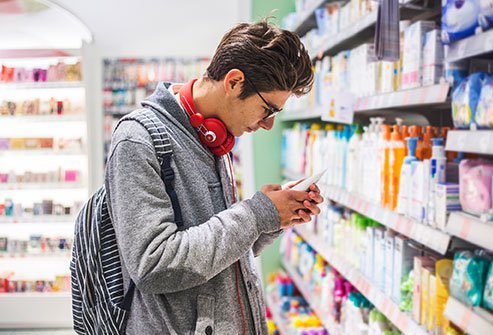What Is the Best Acne Treatment for Guys?
What is acne?

Acne is a skin condition that develops when oil (sebum) and dead skin cells block the hair follicles, which cause inflammation due to the overgrowth of bacteria in the area. Acne (pimples) commonly occurs over the face, neck, back, and chest.
What are the most common types of acne?
Blackheads and whiteheads are common forms of acne. Blackheads (open comedones) form in the skin when pores get clogged with dead skin cells and excess sebum from the sebaceous glands. Blackheads are not the same as whiteheads. Whiteheads (closed comedones) are closed pores clogged with oil, bacteria, and dead skin cells, whereas blackheads have open surfaces, appearing dark in color.
In men, acne can be a result of excess activity of the male sex hormones, such as testosterone.
What are ways to treat acne in men?
Pinching or trying to pick at acne can be tempting but should be avoided because it may result in infection, scarring, and hyperpigmentation. There is no single best treatment for acne. Acne can be treated and controlled with a consistent skincare regimen and medical treatment if required.
There are several ways to get rid of acne, prevent future breakouts, and improve the overall health of the skin.
Cleansing with salicylic acid
Salicylic acid is an effective ingredient to treat acne and improve skin texture. It is an exfoliating agent. It breaks down the materials that clog the pores, such as dead skin cells and excess sebum. Several over-the-counter products containing salicylic acid can be safely used every day. Cleansing the face two times a day and after exercising (with a cleanser that contains salicylic acid) can improve the skin. Salicylic acid is also good for those with dry skin. Some people may be sensitive to salicylic acid. Hence, use it once every few days and then gradually increase the frequency of usage. Discontinue its use in case of allergic reactions.
Daily exfoliation and cleansing with AHAs and BHAs
Regular exfoliation with alpha-hydroxy acids (AHAs) and beta-hydroxy acids (BHAs) can help remove excess sebum and dead skin cells, as well as unclog pores, gently removing existing acne. Regular exfoliations prevent a recurrence, reduce fine lines and pigmentation, and improve skin tone. AHAs and BHAs also cleanse the skin of dirt and other impurities. Glycolic acid is the most popular AHA, and salicylic acid is the most popular BHA.
Several over-the-counter products contain either or both glycolic acid and salicylic acid. They are safe to use every day. Cleansing the face two times a day with a cleanser that contains these acids can improve the skin. There are also toners, serums, and masks that contain either one or both salicylic and glycolic acid. Some people may be sensitive to AHAs and BHAs; hence, they can use it once every few days or start with a low percentage of the acid and gradually increase the strength and frequency of usage. Discontinue its use in case of allergic reactions.
Using a skin brush
Using a skin brush is a type of mechanical exfoliation. Skin brushes can help remove excess dead skin cells and improve skin texture. They typically have fine, soft bristles. They may be electronic or manually operated. Skin brushes may be used one or two times a week with a gentle cleanser or a cleanser containing AHAs and BHAs. Over-exfoliation can be abrasive to the skin and cause skin damage. Those with sensitive skin should avoid skin brushes.
Topical retinoids
Retinoids are highly effective in stubborn cases of acne. They also effectively reduce wrinkles and pigmentation. Retinoids should be used with caution. People usually experience visible peeling, dryness, burning, redness, and increased sensitivity to the sun (hence should be applied only at night and applying sunscreen is a must). It can take the skin 4-6 weeks to get accustomed to retinoids. One may start with applying low-strength over-the-counter retinoids, two to three times a week, and gradually increase the strength and frequency of usage. Higher strengths of retinoids require a doctor's prescription. Oral retinoids (isotretinoin) may be prescribed to those with severe acne.
Using a face mask
Clay, charcoal, and other masks that contain sulfur can help remove excess sebum, unclog pores, and detoxify the skin. Face masks may be used one to two times a week.
Visiting a dermatologist
If there are no improvements despite using over-the-counter products for 4-6 weeks or negative reactions to these products, one may consider visiting a dermatologist for specialized treatment. A dermatologist may suggest chemical peels, prescription medications (antibiotics, oral retinoids), microdermabrasion, medical facials, laser, and other skin treatments.
